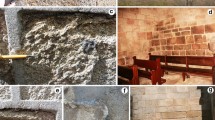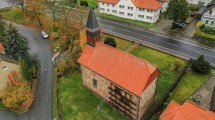Abstract
Surface properties, especially albedo, and aspect are widely accepted as strong influences on the surface thermal response of building stone to insolation. However, the influence that adjacent areas of stone with very different surface properties may have on the thermal response of a patch of stonework, and the ways in which spatial variation in thermal characteristics might enhance stone decay has received relatively little attention. This paper examines the differential thermal response of granite used in construction that results from the presence of dark coloured micro-granular enclaves within a leucocratic host. Surface temperatures and temperature differences between enclaves exhibiting mico-spalling, enclaves with no spalling and the surrounding stone were measured for different aspects and seasons on a 20th century building in Madrid. These data were used to calculate a number of “indices” related to short-term temperature cycling and temperature gradients that have the theoretical capability of generating irreversible deformation of the stone. These indices suggest that micro-spalling of enclaves, compared to a lack of similar decay on the host-rock, is related to their differential thermal response to insolation, most importantly the lower albedo and thermal conductivity values of the enclaves. However, these factors are not sufficient on their own to trigger spalling, and breakdown was only observed where enclaves also experienced repeated, short-term surface temperature cycling caused by, for example, temporary shading by adjacent vegetation. These rapid temperature reversals are identified as a key contributory factor to the thermally driven decay observed on some of the enclaves.









Similar content being viewed by others
References
Bernardi A, Vincenzi S (1993) Modelling daily thermal cycles in the Trajan Column. Sci Total Environ 128:257–267
Camuffo D (1998) Microclimate for cultural heritage. Elsevier, Amsterdam
CIE—Commission Internationale de l’Eclairage (1986) Colorimetry, 2nd edn. Publication CIE 15.2. Bureau central de la CIE, Paris
Egerer F, Kertesz P (1993) Introduction to petrophysics. Akademiai Kiado, Budapest
Fort R, Alvarez de Buergo M, Mingarro Martin F, López de Azcona MC (2004) Stone decay in 18th century monuments due to iron corrosion. The Royal Palace, Madrid (Spain). Build Environ 39(3):357–364
Gómez-Heras M (2006) Procesos y formas de deterioro térmico en piedra natural del patrimonio arquitectónico. UCM Publicaciones, Madrid
Gómez-Heras M, Smith BJ, Fort R (2006) Surface temperature differences between minerals in crystalline rocks: Implications for granular disaggregation of granites through thermal fatigue. Geomorphology 78(3–4):236–249
Hall K (2007) Evidence for freeze-thaw events and their implications for rock weathering in northern Canada: II. The temperature at which water freezes in rock. Earth Surf Process Landf 32:249–259
Hall K, André MF (2003) Rock thermal data at the grain scale: applicability to granular disintegration in cold environments. Earth Surf Process Landf 28:823–836
Hall K, Hall A (1991) Thermal Gradients and rock weathering at low temperatures: some simulation data. Permafrost Periglac 2:103–112
Hall K, Meiklejohn I, Arocena J (2007) The thermal responses of rock art pigments: Implications for rock art weathering in southern Africa. Geomorphology 91:132–145
Hall K, Guglielmin M, Strini A (2008) Weathering of granite in Antarctica: I. Light penetration into rock and implications for rock weathering and endolithic communities. Earth Surf Process Landf 33:295–307
Halsey DP, Mitchell DJ, Dews SJ (1998) Influence of climatically induced cycles in physical weathering. Q J Eng Geol 31:359–367
Iñigo AC, Vicente-Tavera S (2002) Surface-inside (10 cm) thermal gradients in granitic rocks: effect of environmental conditions. Build Environ 37(1):101–108
Jenkins KA, Smith BJ (1990) Daytime rock surface temperature variability and its implications for mechanical rock weathering: Tenerife, Canary Islands. Catena 17(4–5):449–459
Kelly WC, Zumberge JH (1961) Weathering of a Quartz Diorite at Marble Point, Mcmurdo Sound, Antarctica. J Geol 69(4):433–446
Kerr A, Smith BJ, Whalley WB, McGreevy JP (1984) Rock temperatures from southeast Morocco and their significance for experimental rock-weathering studies. Geology 12:306–309
Koch A, Siegesmund S (2004) The combined effect of moisture and temperature on the anomalous expansion behaviour of marble. Environ Geol 46:350–363
Logan JM (2004) Laboratory and case studies of thermal cycling and stored strain on the stability of selected marbles. Environ Geol 46:456–467
McGreevy JP (1985) Thermal properties as controls on rock surface temperature maxima, and possible implications for rock weathering. Earth Surf Process Landf 10:125–136
McGreevy JP, Warke PA, Smith BJ (2000) Controls on stone temperatures and the benefits of interdisciplinary exchange. J Am Inst Conserv 39(2):259–274
Menduiña J, Fort R, García del Cura MA, Galán L, Pérez-Monserrat E, Fernández-Revuelta B, Bernabeu A, Varas MJ, Bellido F (2005) Las piedras utilizadas en la construcción de los Bienes de Interés Cultural de la Comunidad de Madrid anteriores al siglo XIX. IGME-IGE, Madrid
MOPTMA—Ministerio de Obras Públicas, Transportes y Medio Ambiente (2001) Guía resumida del clima de España, 1971–2000: Plan Estadístico Nacional 2001–2004. Centro de Publicaciones MOPTMA, Madrid
Neila González FJ (2000) El soleamiento del edificio I. El sol y la radiación solar. Cuadernos del Instituto Juan de Herrera. Instituto Juan de Herrera–ETSAM, Madrid
Paradise TR (2002) Sandstone weathering and aspect in Petra, Jordan. Z Geomorphol 46(1):1–17
Peel RF (1974) Insolation weathering: Some measurements of diurnal temperature changes in exposed rocks in the Tibesti region, central Sahara. Z Geomorphol N F Suppl Bd 21:19–28
Rice A (1976) Insolation warmed over. Geology 4:61–62
Scheffzuk C, Siegesmund S, Koch A (2004) Strain investigations on calcite marbles using neutron time-of-flight diffraction. Environ Geol 46:468–476
Shaler NS (1869) Notes on the concentric structure of granitic rocks. Proc Boston Soc Nat Hist 12:289–291
Siegesmund S, Mosch S, Scheffzük Ch, Nikolayev DI (2008) The bowing potential of granitic rocks: rock fabrics, thermal properties and residual strain. Environ Geol. doi:10.1007/s00254-007-1094-y
Smith BJ (1977) Rock temperature measurements from the northwest Sahara and their implications for rock weathering. Catena 4(1–2):41–63
Streckeisen A (1976) To each plutonic rock its proper name. Earth-Sci Rev 12(1):1–33
Warke PA, Smith BJ (1998) Effects of direct and indirect heating on the validity of rock weathering simulation studies and durability tests. Geomorphology 22(3–4):347–357
Warke PA, Smith BJ, Magee RW (1996) Thermal response characteristics of stone: implications for weathering of soiled surfaces in urban environments. Earth Surf Process Landf 21:295–306
Winkler EM (1977) Insolation warmed over: comment. Geology 5(3):188–189
Yatsu E (1988) The nature of weathering: an introduction. Sozosha: Overseas distributor Maruzen Co., Tokyo
Acknowledgments
The authors want to acknowledge to the Heritage Service and Security Staff of the CSIC and to C. Vázquez-Calvo, G. Fernández, and Dr. M. Álvarez de Buergo for their assistance during this work.
Author information
Authors and Affiliations
Corresponding author
Rights and permissions
About this article
Cite this article
Gómez-Heras, M., Smith, B.J. & Fort, R. Influence of surface heterogeneities of building granite on its thermal response and its potential for the generation of thermoclasty. Environ Geol 56, 547–560 (2008). https://doi.org/10.1007/s00254-008-1356-3
Received:
Accepted:
Published:
Issue Date:
DOI: https://doi.org/10.1007/s00254-008-1356-3




